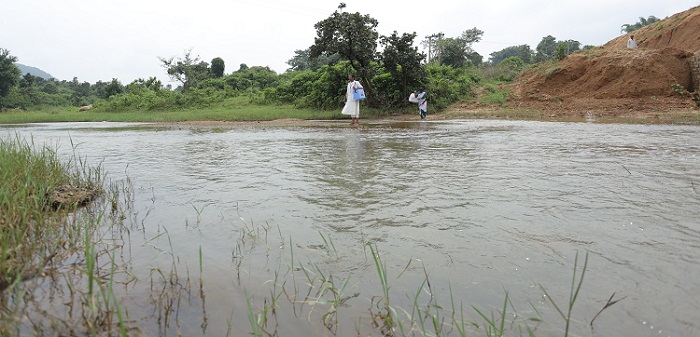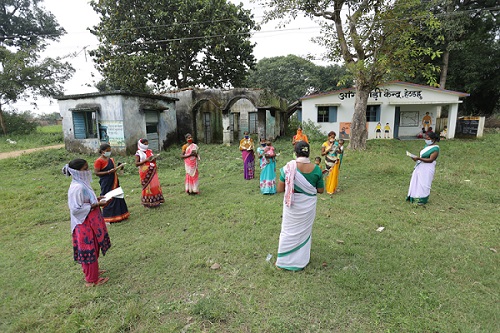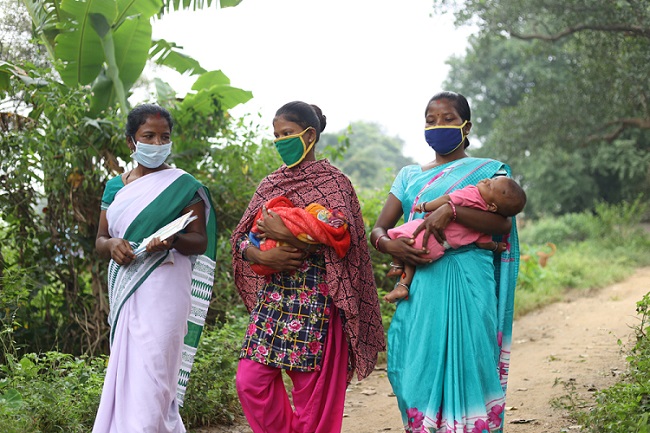Let’s hear some voices first, else it will be drowned in the din of the virus pandemic, election results, coal mafia arrests, Bollywood stars and the endless wait for life-saving vaccines. This story is about India, more importantly, and Indian women.
Anju Chaudhary works as a part of a Self Help Group in Tapu village of Chopan block in UP’s Sonbhadra district which once made breaking headlines for its gold deposits. But for some strange reasons, the Geological Survey of India (GSI) retracted its claim and no one went for the hunt like Mackenna’s Gold.
Chaudhary received training on routine immunization and hand washing with soap last November under a UNICEF project, the idea was to mobilize families on routine immunization and hand washing with soap.
But pandemic COVID-19 hit her journey, routine immunization work got impacted in Uttar Pradesh. Chaudhary took online training on COVID-19 interventions and was told to spread the message wide and far. And then she, along with 24 women, reached 79 community members and prepared their community to respond correctly during COVID-19.
It was a tough call but she managed, she had support from Ministry of Health and Family Welfare, which worked in tandem with the centre and state governments, and also UNICEF.
Now meet Sulekha Devi of Iama village from Fatehpur block of Gaya district that is known for Shiva temple and thousands and thousands of priests ready to fix your hotline with Lord Shiva.
A member of Jeevika group in 2013, Sulekha Devi received training on routine immunization and hand washing with soap constantly encouraged parents to get their child immunized. She trained virtually in May this year. Once Devi was trained, she learnt three migrant labourers from Kolkata and one migrant labourer from Ranchi have arrived into her village but were not willing to go to the quarantine center and wanted to live with their family. Devi led the charge, advising them to go to the quarantine center to save their family and village from any possibility of getting infected from COVID-19. She helped those four migrant labourers understand the importance of being isolated from the family in adequate facilities.
She did not make breaking headlines in a nation where news channels make and break heroes and heroines. She did her exceptional work silently, very silently.
And finally, meet this one.
Laxmi Kunjam, a Self Help Group member in Dantewada that is always in news for Maoist operations and gruesome deaths, got ventilation therapy through discussions and ensured safety through immunization for every child from diseases in her village. It was like clearing a medical examination.

Kunjam’s home is in Koriras village of Katekalyan Block of Dantewada. The village has always been a tough one for the Rural Health Organizer (RHO) for immunization because many lactating women were reluctant to get their child immunized despite several rounds of counselling. There were also prevailing myths and misconceptions that a child gets fever and other health issues, after immunization. Laxmi turned the tide around. The Routine Immunization process was thoroughly internalized by Laxmi who conducted inter-personal communication with more than 80 mothers in the village and its surrounding villages. In total she brought back 6 such missing cases in Koriaras village and contacted every missing child in the village for immunization.
“We don’t want even a single child to be missed for immunization from our village. We will keep thinking on this line always, she said in an interview. Thanks to Laxmi, the entire village is free from the invalid myths and every child is immunized.
Mainly due to some great push by the Ministry of Health and Family Welfare and UNICEF, such women across India are pushing India’s immunization drive to greater heights.
But thanks to these women and the Ministry of Health and Family Welfare’s immunization drive, work is picking up in states such as Delhi, Chattisgarh, Maharashtra, West Bengal, Uttar Pradesh, Jharkhand and Haryana. It is a fact that this delay was anticipated due to the Covid-19 pandemic. So on April 14, 2020, the Ministry of Health and Family Welfare (MoHFW), sent a letter to all principal secretaries, chief secretaries and administrators, stressing on the need to maintain non-Covid essential services.
“There were some gaps in coverages seen due to the pandemic due to restriction in movement of man and material to contain the spread. However, GOI came up with guidelines to ensure access to essential services in mid April that resulted in guiding the states on how to conduct vaccination sessions by taking due precautions. The states too worked on innovative ideas and the services have now been restored,” said a senior officer from the Ministry of Health and Family Welfare, Government of India.
The guidance note that went along with the letter to the state governments included a letter that said services must include “reproductive, maternal, new-born and child health, prevention and management of communicable diseases, treatment for chronic diseases to avoid complications, and addressing emergencies”.
But the challenge lies in implementation.
“Immunisation programmes should start on a priority basis and the government must analyse the risk versus benefits. We cannot afford another epidemic at the cost of one epidemic,” says Dr Naveen Thacker, executive director of International Pediatrics Association.
Dr Thacker says the lack of shortage of community workers, fear among healthcare workers over contracting COVID-19 are the biggest issues in India. Then there are issues over availability of PPEs, and resistance from village or panchayat heads in rural areas to allow HCWs to carry out the drives during the pandemic.
Now let’s consider this study by the World Health Organization (WHO) on 129 countries. It says disruption to inoculation services may put approximately 80 million babies at the risk of getting diseases such as diphtheria, measles and polio. So what is the way out for a billion plus India? If immunization services must be suspended, there must be an urgent catch-up in vaccinations as soon as possible.
But who will do it? It is almost like saying public smoking is banned but there are no cops for implementing the law.
Since its inception, the Universal Immunisation Programme (UIP) — one of the largest public health programmes in the world — has protected millions of children from vaccine-preventable diseases like diphtheria, pertussis, measles, pneumonia, diarrhoea, etc.

So how has the current suspension affected India? A quarter of Indian children still die of pneumonia and diarrhoea, yet one has to wait longer than earlier expected to ensure everyone has access to the life-saving vaccines.
It is working feverishly to declare vaccinators as first line responders. With protective gear and mobile technology, they could effectively sustain immunisation activities while practicing the mandated physical distancing.
Intersectoral collaborations will be critical to immunisation infrastructure — scientists, researchers, policymakers, economists, and civil society organisations and private organizations have to come together to design a roadmap to cover lost ground.
Thanks to some great push by UNICEF, these wonder women are collectively carving out a meticulous risk management, financing and executive plan to ensure access to the usual state-aided nutritional supplements to keep immunization levels high in the hinterland.

It is slowly showing results. For example, the problem of floating populations in slums, where many relocate periodically, means some areas may remain uncovered by Anganwadi workers. Again, the family survey is done only once a year in April, and this year even that could not be done. Pregnant women may get added to the list by anganwadi workers during quarterly or half-yearly surveys. Now if a pregnant woman in a densely-populated slum misses these surveys, she can access Integrated Child Development Services (ICDS) aid if she visits the anganwadi and gets registered. India, the world’s largest democracy, recorded nearly 67,385 births in 2020 on New Year’s Day. The country, home to the highest number of unvaccinated children, has embarked upon an intensified journey to increase the vaccination coverage with mission Indradanush 2.0. It is here that the help of these superwomen come handy.
According to the Indian National Statistical Office (NSO) 97 percent of children between 0-5 years in the rural setting receive at least one vaccine, but when it comes to those children being fully immunised, the percentage drops to 58 per cent. Despite the government spending billions of dollars in programs like Mission Indra Dhanush, India’s immunisation rate remains one of the lowest in the world.
But the women who work against the odds in the countryside know healthcare for young children eventually determine the country’s economic productivity, because vaccine-preventable diseases are known to cause stunting in childhood, which can lead to poor growth, poor adult health, and diminished learning capacity of the children. Their mornings are spent making calls and follow-ups to remind parents from financially disadvantaged backgrounds to get their child vaccinated, now that the immunisation programme has resumed across India.
So there is no let up in their works. The women know that in India, covid-related disruptions to the country’s immunisation and vaccination programmes has created a real risk of a measles outbreak — suggesting a nightmare scenario of overburdened public health systems trying to cope with simultaneous outbreaks of measles and Covid-19. Worse, hectic contact tracing, testing, and quarantining demands placed by the pandemic has made it almost impossible to find the time for the immunisation programme.
The World Health Organisation and UNICEF says only 20 percent of the children born in the present day will be fully vaccinated with all globally recommended vaccines by the time they turn five. The report says 80 million children in 68 countries are at risk of contracting diphtheria, polio and measles.
“COVID-19 has made previously routine vaccination a daunting challenge,” UNICEF Executive Director Henrietta Fore said in a report issued by WHO and UNICEF. “We must prevent a further deterioration in vaccine coverage and urgently resume vaccination programs before children’s lives are threatened by other diseases. We cannot trade one health crisis for another.”
Approximately, 27 million infants and 29 million pregnant women are covered under India’s immunisation programme every year. Nine million sessions are conducted to deliver 12 preventive vaccines like the bivalent oral polio vaccine, inactivated polio vaccine (IPV), HPV, pentavalent, measles and rubella virus. These are given at the ages of 2, 4, 6,9 and 18 months. The role of the women health workers assumes paramount importance.
This year in April, however, a minimum of one lakh children did not get BCG vaccine for tuberculosis and two lakh children were not given the pentavalent and rotavirus vaccines that build immunity against meningitis, pneumonia, diphtheria and tetanus, says the Centre’s National Health Mission. The data further revealed that there was a 34 per cent drop in the number of measles vaccines across India between February and March.
This is alarming, India has the fourth-highest number of measles cases in the world as per WHO.
Luigi d’Aquino, Chief of Health, UNICEF India said: “Vaccination is one of the most effective and cost-effective ways to protect children’s lives and futures, and for building healthier and safer communities. It is vital to ensure that immunization services continue to be available to every child, and that communities, families, and caregivers of children are continually aware of the importance of full immunization.”
But how has the set-up for the immunization process changed to facilitate COVID-19 precautions?
D’Aquino said there has been a great effort and focus on prevention and containment of COVID-19 but at the same time, the government has taken several steps to resume the Immunization services and prevent the community at large from the vaccine preventable diseases.
The UNICEF health boss said the Alternate Vaccine Delivery (AVD) system helped health workers during and after the lockdown in ensuring the availability of vaccines. “The AVD system is a very well established system in the country. The states have different vaccine delivery mechanisms depending on the topography of the state ranging from motorcycle/bikes, cycle, boats and by foot. During and after the lockdown; when the regular road transport mechanism was affected, the AVD system was functional and it supported in vaccine delivery and resumption of Routine Immunization services. The AVDs are based on local need and depending upon local support and means for transport . There could be anywhere between 1 to 2 lakh persons or more working as AVDs.”
Due to COVID-19, there was a dip in the number of women or children who came to get vaccinated. There was a decline in the initial months of lockdown (April and May 2020), however recovery trends were seen in the subsequent months. India was quick to respond to this unprecedented situation. Within weeks of lockdown, the Ministry of Health and Family Welfare and Ministry of Home Affairs issued guidelines declaring public health services, including immunization, as an essential service. These new guidelines made the sessions fully functional across the country. And the results have been telling. Basic immunisation services received a huge boost and the vaccination drive reached pre-pandemic levels, said D’Aquino.
Let the band of women grow.

